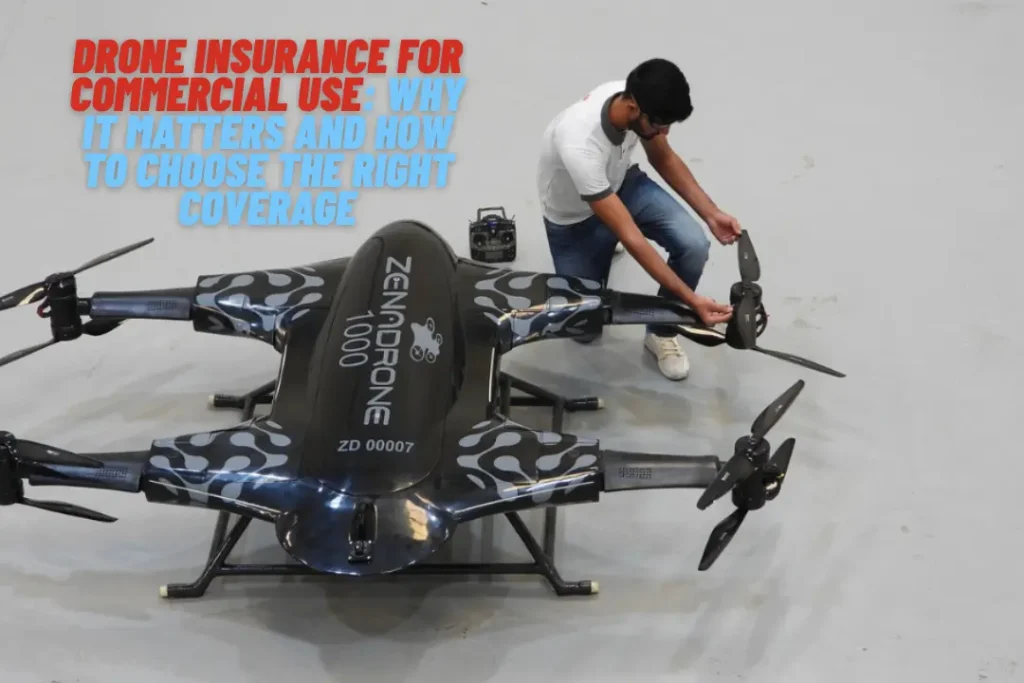Drone Insurance for Commercial Use: Why It Matters and How to Choose the Right Coverage

The rise of drones has transformed industries across the United States. From aerial photography and filmmaking to agriculture, construction, logistics, and emergency services, drones (also known as UAVs—unmanned aerial vehicles) have become indispensable tools for modern businesses.
But with opportunity comes risk. A drone accident can lead to property damage, bodily injury, regulatory fines, or costly lawsuits. That’s where drone insurance for commercial use comes in. Just as cars, offices, and employees need protection, drones and their operators also require specialised coverage.
In this article, we’ll dive deep into why drone insurance is essential, what it covers, how much it costs, and how businesses can choose the right policy to protect their investment.
Why Commercial Drone Insurance is Essential
Unlike recreational drone flying, commercial use involves higher stakes. A simple crash during a wedding shoot or construction survey could mean tens of thousands of dollars in damages—not to mention legal claims.
Key reasons drone insurance is essential for commercial operators:
- Liability Risks: Drones can accidentally collide with property, vehicles, or even people. Without liability coverage, the business bears the financial burden.
- Regulatory Compliance: While the FAA (Federal Aviation Administration) doesn’t mandate insurance, many states, cities, and clients require it before hiring drone operators.
- Professional Reputation: Having insurance signals professionalism. Many clients only hire drone pilots who carry coverage.
- Business Continuity: Insurance ensures that a single accident doesn’t shut down your operations.
Real-world example: In 2023, a wedding videography company in California faced a lawsuit after a drone struck a guest, causing medical injuries. The company’s liability insurance covered medical bills and legal expenses—without it, the business could have gone bankrupt.
Types of Drone Insurance for Commercial Use
Just as businesses have multiple types of insurance (liability, property, and workers’ compensation), drone insurance also comes in several forms.
1. Drone Liability Insurance
This is the most important coverage for commercial operators.
- Covers third-party bodily injury and property damage.
- Required by many clients and venues before allowing drone flights.
- Typical coverage ranges from $500,000 to $10 million, depending on business size.
2. Hull Insurance (Physical Damage Coverage)
- Protects the drone itself against crashes, theft, fire, or natural disasters.
- Especially important for high-end drones like DJI Inspire, Matrice, or custom UAV rigs.
- Coverage usually equals the replacement cost of the drone and attached equipment.
3. Payload Insurance
- Covers cameras, sensors, and expensive attachments.
- Useful for surveyors, agricultural drones, and filmmakers using $10,000+ cinema cameras.
4. Personal Injury Insurance
- Covers claims such as invasion of privacy, defamation, or improper use of aerial footage.
- Relevant for drone photographers and media companies.
5. Cyber Liability Insurance
- Protects against hacking, data theft, or GPS signal interference.
- Increasingly important as drones store sensitive client data.
6. Non-Owned Drone Insurance
- Coverage for businesses that rent or lease drones instead of owning them.
Who Needs Commercial Drone Insurance?
Drone insurance is not just for large corporations—it’s relevant to many industries in the U.S.
- Real Estate Agencies: Using drones for aerial property tours.
- Construction & Engineering Firms: Conducting site surveys, safety inspections, and progress documentation.
- Agriculture Businesses: Crop spraying, field monitoring, and livestock management.
- Film & Media Production: Movies, commercials, and event coverage.
- Logistics Companies: Testing drone delivery programs.
- Public Safety & Emergency Response: Police, fire, and disaster relief operations.
In short: If you’re making money with a drone, you need insurance.
How Much Does Drone Insurance Cost in the USA?
Pricing varies based on several factors:
- Type of coverage (liability vs. full coverage)
- Drone model and value (a $1,000 drone vs. a $20,000 cinema drone)
- Flight frequency (occasional vs. daily use)
- Location of operations (rural areas vs. busy cities)
- Risk profile of industry (real estate has lower risk than drone delivery).
Typical cost ranges:
- Liability-only coverage: $500 – $800 per year
- Full coverage (liability + hull + payload): $1,000 – $3,000 per year
- On-demand insurance (per flight): $10 – $30 per flight, available via apps like SkyWatch.AI or Verifly
Best Drone Insurance Providers in the USA (2025 Update)
The drone insurance market in the U.S. has grown rapidly, with specialised providers and traditional insurers offering policies.
Top commercial drone insurance companies in 2025:
- SkyWatch.AI
- Flexible on-demand or annual plans.
- Coverage starts as low as $10/hour.
- The mobile app allows instant coverage before a flight.
- Verifly (Thimble)
- On-demand, per-flight insurance.
- Great for freelancers or occasional operators.
- Global Aerospace
- Comprehensive annual policies.
- Widely used by corporate fleets and large drone operators.
- BWI Fly (BWI Aviation Insurance)
- Known for tailored UAV insurance plans.
- Coverage options for liability, hull, and payload.
- State Farm (select states)
- Some policies are available for drones under personal articles insurance.
- DroneInsurance.com (Tokio Marine)
- Highly flexible coverage for fleets and enterprise clients.
How to Choose the Right Drone Insurance Policy
With so many options, how do you select the best coverage for your drone business?
Key tips:
- Assess your risks: High-value drones or heavy payloads require hull and payload coverage.
- Check client requirements: Many clients demand $1M+ liability coverage.
- Consider frequency of flights: Frequent flyers may prefer annual plans; occasional pilots may benefit from per-flight insurance.
- Compare providers: Look at coverage exclusions, customer reviews, and claim process efficiency.
- Bundle if possible: Some insurers allow bundling drone insurance with business liability coverage.
Drone Insurance and FAA Regulations
While the FAA doesn’t mandate insurance, it regulates Part 107 drone operations in the U.S. Many clients—especially in construction, government contracts, and real estate—won’t hire drone operators unless they carry insurance.
Additionally, some local governments and airports require proof of liability coverage before granting flight permissions.
Future of Drone Insurance in the USA
As drone usage expands into delivery services (Amazon Prime Air, UPS Flight Forward) and advanced aerial mobility, insurance models will evolve. By 2030, PwC estimates the drone insurance market could exceed $1 billion annually in the U.S.
Trends to watch:
- AI-driven risk assessments based on drone telemetry.
- More affordable on-demand coverage for freelancers.
- Cyber liability is becoming standard as drones rely more on cloud-based flight systems.
Conclusion: Protecting Your Drone Business
Drones are powerful tools, but they come with risks. Whether you’re a real estate photographer, an agricultural surveyor, or a large-scale drone delivery company, commercial drone insurance protects your equipment, your clients, and your reputation.
By understanding coverage types, comparing providers, and choosing the right plan, businesses can fly confidently—knowing that an accident won’t ground their success.
Related Posts

Best Budget Drone for Real Estate Photography In 2025

Price Of Elios 3 Surveying Drone

